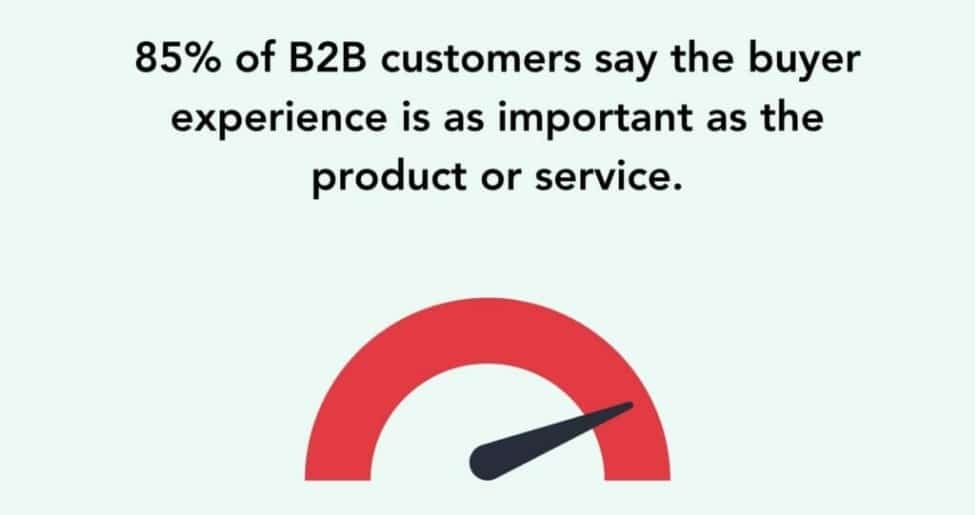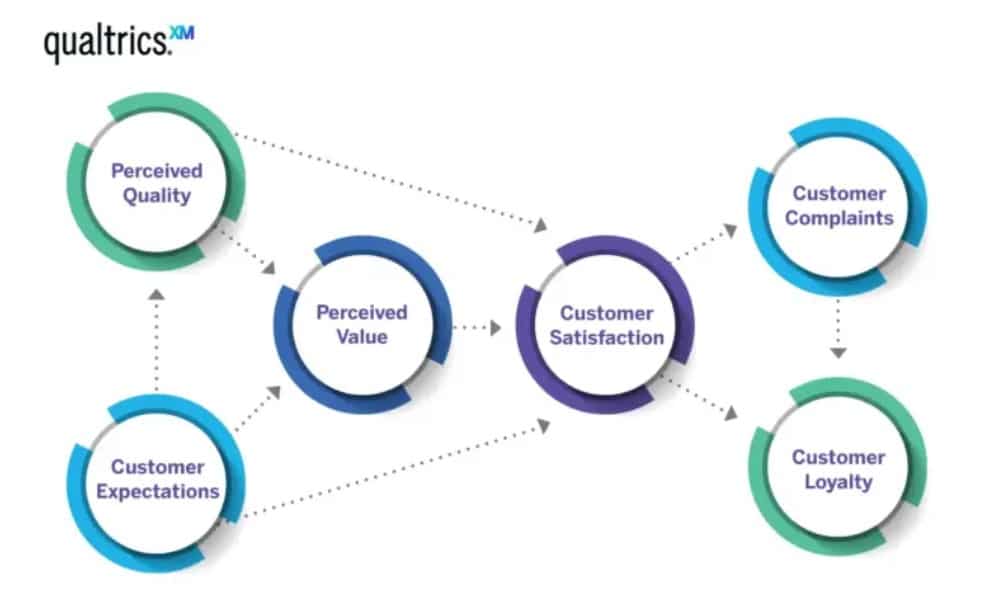While there may be many differences between B2B and B2C companies, there is one thing they most definitely have in common; a good customer experience can mean repeat customers. In fact, 80 percent of B2B customers expect the same level of experience as a B2C customer and 86 percent will pay more for a great customer experience. So, what’s the best way to conduct a B2B customer satisfaction survey that ensures your organization is providing one?
Outlining B2B customer satisfaction surveys
While the primary goal is to measure how satisfied your clients, customers, and partners are, you also want your survey to collect data that can give you deep insights and that can allow you to make informed decisions. It can also help you to better understand the needs and preferences of your B2B customers and how happy they are with your service (and products).

Image sourced from customersfirstacademy.com
Of course, one major difference between B2B and B2C surveys is that you are dealing with customers who will have significantly higher AOVs (average order value) and CLVs (customer lifetime value). Where a B2C company may have millions of customers, a B2B business may have only thousands, so it is essential that you get things right.
4 steps to conducting a B2B customer satisfaction survey:
1. Define your goals
You may choose to conduct several surveys in the course of a year, and your first step is to decide what the objective of each survey is. That means establishing what it is you want to learn, what your expectations of the survey are, and what your plan is for the data collected.
Some of your goals could include:
- Ensuring your customers are happy, both with the products you offer and the service provided.
- Identifying any pain points that have driven people to your competitors.
- Collating data for use in marketing messages and content.
- Helping you predict future customer needs and the need for any product development or upgrade. For example, if you provide contact center as a service solutions, then a survey could reveal any need for added or upgraded features.
Remember, you can create surveys that combine two or more goals. These can help give you a more rounded view of people’s perception of you.
2. Determine your methodology
So, you’ve decided on what your survey objectives are; now you need to decide how you will conduct the survey. It can help to monitor what is being said about your business in the media and on social media. Some of the common survey types you could utilize includes:
- Email survey: Non-intrusive, especially if you give respondents time to fill the survey out. A good benchmark is to ensure the survey can be completed in 15 minutes or less.
- Website survey: You could place a link to this on your home page. The problem with this
- Image sourced from customersfirstacademy.com type of survey is that your customers may only visit your site occasionally.
- Phone survey: Many B2B clients will have close relationships with one (or more) of your staff, making this a good option. Again, think about length and stick to a maximum number of about 10 questions.
- Focus groups: Focus groups can be very effective when you want to identify feelings about something specific. For example, if you recently launched a new VoIP caller product, a focus group can openly discuss what’s good and bad about it.
3. Decide on your metrics
Once you have decided on the type of survey, you also need to decide what sort of metrics you are going to use from the data collected. Metrics can measure everything from how customers feel about a specific product to how they feel about your customer service or their overall impression of your business. Popular metrics include:
- NPS (net promoter score): Measured on a scale of 0-10, this shows how likely a customer is to recommend you to others. The scores are split into three groups; 0-6 are detractors who are unlikely to remain loyal and may even say negative things. 7 and 8 are passives who are likely to neither promote or criticize you. And 9 and 10 represent your most loyal customers who may even become brand ambassadors.
- CES (customer effort score): This can be a useful metric when you sell technical products or tools such as screen sharing software. It can reflect how easy customers find your products to use and you can combine your CES question with other questions to give you better insights into what you need to change (if anything).
- CSAT (customer satisfaction score): This is a good metric for measuring the general satisfaction levels of your customers. Scales can vary (1-5, 1-7, or 1-10), and can take the form of numerical values or emojis (happy face to angry face). You calculate your actual CSAT by dividing the total number of happy customers by your total number of customers.

Image sourced from qualtrics.com
4. Collect, analyze, and act
So, your B2B customer satisfaction survey is completed and you have the data. Depending on what your objectives were, you now want to sort the results into relevant datasets, analyze them, and look at the ‘final scores’. Analysis of the data collected from the surveys can give you informed insights and allow you to make decisions in a number of areas. It can also help your PR strategy to be transparent about the data and results you have collected.
Of course, the perfect result would be for all your customers to be extremely happy and you not having to take any action. But it is more likely that the results may identify issues, no matter how small, that you can then take action on. It could be that you need to improve your tech support service, look at adding new features to existing products, or even develop a new product.

The takeaway
One important thing to note is that you should be conducting surveys on a regular basis (but not so often that it annoys your customers). The B2B market is constantly changing and evolving; new products, new features, new expectations. By keeping a finger on the pulse of your customers’ feelings and thoughts, you can ensure that you keep ahead of your competitors.
You want your business to not just survive, but to grow and expand. And, depending on the sector you operate in, change can be almost constant. A B2B customer satisfaction survey is not just about showing you how happy your customers are, but also what they want and expect from you in the future.




